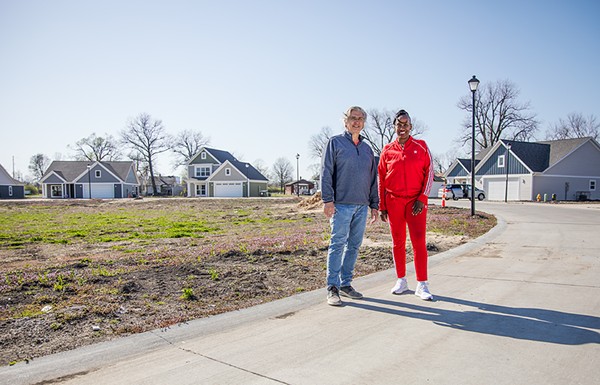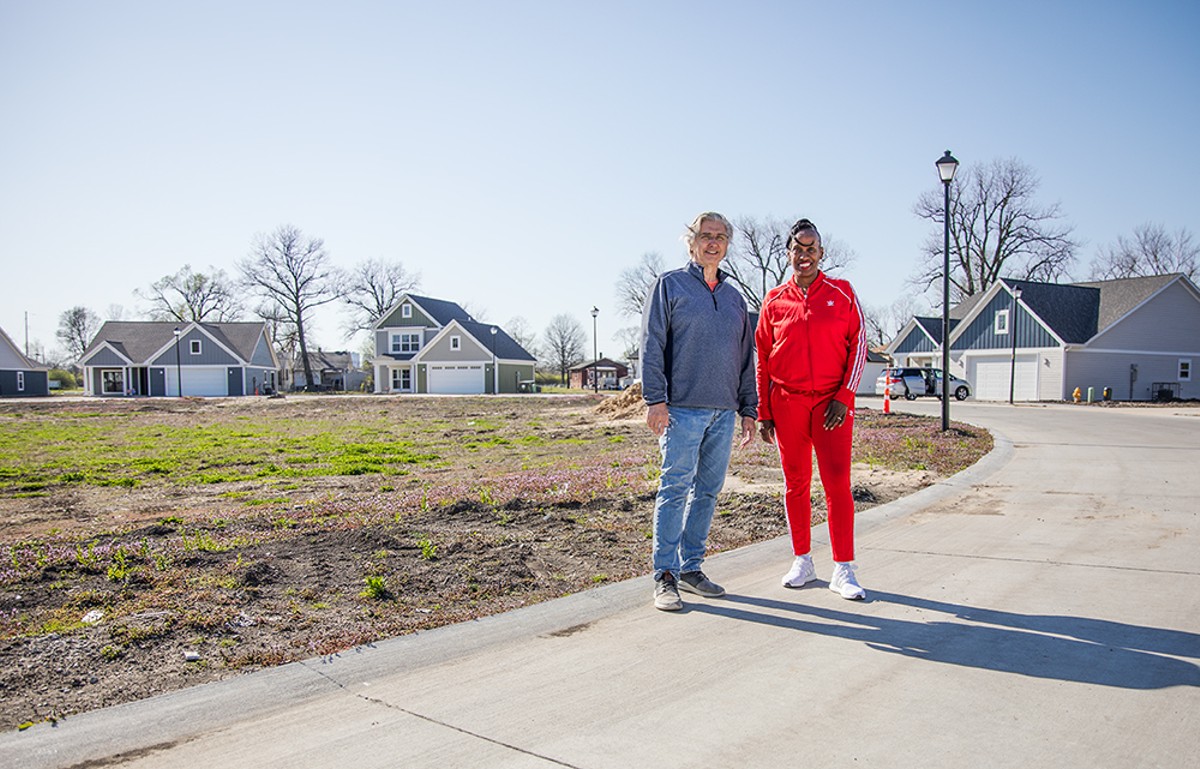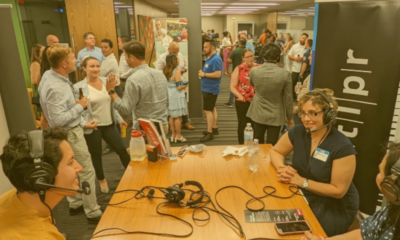Local News
They Built New Housing in East St. Louis. Now They Need People to Buy Into Their Vision

[ad_1]

River barge magnate Mark Mestemacher has a rich history of establishing and supporting wrestling programs for young people around the region. That includes the East St. Louis Wrestling Club, which he founded in 2008 and housed in the Jackie Joyner-Kersee Center.
But just one year later, the JJK Center shut down due to financial problems, laying off 32 employees. Mestemacher, who lived in Edwardsville, had stayed in his lane, and hadn’t had much, if any, involvement with the Center outside of his program. In the wake of the closure, someone suggested he meet with the legendary Olympian.
The meeting changed his life.
“We cried 45 minutes out of that first hour,” Mestemacher, now 67, recalls. “The need was so great, and she had such a desire to make a difference in the lives of people.”
Long before she won Olympic gold in the heptathlon and the long jump, Jackie Joyner grew up in an underprivileged neighborhood in East St. Louis. But in the 1960s, she watched a space-age geodesic domed building being erected in nearby Lincoln Park, which would open as the Mary Brown Community Center. “It became my second home,” Joyner-Kersee recalls.
The center gave her many opportunities and enriched her life — opportunities she wanted to provide others. But at that time, in 2009, her dream was slipping away.
With their shared passion for helping children, a love of sports, and deep religious faith, the two bonded instantly. Mestemacher took their connection as a sign from God that he needed to adopt Joyner-Kersee’s dream for East St. Louis as his own. He joined the Center’s board and personally paid off the substantial debts. After two years of rebuilding the organization, the Center resumed operations in 2012.
“There were people who suggested bankruptcy,” recalls former board member Debra Aerne. “But Jackie was against that, and they” — Joyner-Kersee, Mestemacher and other board members — “didn’t want anyone to be able to say they were cheated by the Center. They wanted to protect Jackie’s name.”
Mestemacher, at least, has now gone far beyond that. The nonprofit organization that his work with Joyner-Kersee helped to inspire, Lansdowne UP, is investing in East St. Louis in a way that might seem unfathomable to anyone who’s driven through the city.
In 1950, East St. Louis was the fourth-largest city in Illinois, with a population north of 82,000. Today, only 17,000 call the beleaguered community home. No market rate subdivision has been built there in at least 50 years.
Lansdowne Park, with homes slated to go on the market in just a few weeks, will be the first.
click to enlarge ZACHARY LINHARES Lansdowne Park’s homes offer open floor plans and high ceilings.
Wrestling With Bigger Ideas
After his life-changing meeting with Joyner-Kersee, Mestemacher’s focus expanded far beyond wrestling and into the city that raised her.
“Facing the Center’s athletic fields, there was a row of derelict drug houses and overgrown lots,” Mestemacher says. “The wrestling club bought them, tore them down and hired the coaches and the kids to clean up the land. Many of these boys don’t have father figures, so this was another opportunity for the coaches to spend time and mentor them.”
Funded by Mestemacher, the East St. Louis Wrestling Club continued to acquire land, and to direct mentoring and job training programs. One day their alarmed accountant informed them that based on revenue, the club had morphed into the largest wrestling organization of its kind in the nation. Concerned that it came off as a money-laundering operation, they were advised to form a separate organization for the non-wrestling activities.
The accountant’s concerns were well-founded. When they tried to spin off Lansdowne UP, it took 18 months of auditing to convince a skeptical IRS.
As Aerne explains, there’s now an entire ecosystem radiating out of the Jackie Joyner-Kersee Center, which includes Mestemacher’s education and development nonprofit Lansdowne UP, of which Joyner-Kersee is on the board, urban farming partnerships with the Donald Danforth Plant Sciences Center and the University of Illinois, and a building trades partnership with Southwestern Illinois College.
Lansdowne UP is taking the lead on the residential development side — and it’s doing it in a way that gets current neighbors involved rather than displacing them.
The nonprofit has purchased more than 2,600 lots in the Lansdowne area of East St. Louis, which is anchored by the Jackie Joyner-Kersee Center and bordered by I-64 to the south, I-55 to the north, 9th Street to the west and 40th Street to the east.
The approximately 250-acre area is already graced by the attractive Jones Park, with its mature trees, horseshoe lake and a pavilion similar to the one in Carondelet Park, but thanks to Lansdowne UP, most of the surrounding area is park-like as well. That’s due to their “Lawns for Learning” initiative, which teaches landscaping skills in the mornings and life skills in the afternoons.
“Our people are paid to learn,” Mestemacher says. “We’ll do things like create a menu and teach them how to shop and then prepare the meal.”
The supervisors at Lansdowne UP are called mentors, and each has only a handful of employees to oversee.
The nonprofit was able to successfully rehab four existing homes, with three more underway. But the vast majority of lots were vacant or had homes too far gone to repair, and those parcels have been cleared. Once garbage and undergrowth are taken away, the lots are mowed and lovingly maintained by the Lawns for Learning participants in their easily recognizable Lansdowne UP shirts or hoodies.
Lansdowne UP has even helped three of its employees start their own lawn businesses, which the organization now contracts with.
click to enlarge ZACHARY LINHARES Jackie Joyner-Kersee grew up in East St. Louis before becoming one of track and field’s all-time greats.
God Had Other Plans
For more than a century, when St. Louisans said they were “going to the East Side,” it meant they were up to no good. But Joyner-Kersee says despite that reputation for vice, East St. Louis was always a city of churches.
“This is a community built on faith,” the warm and approachable Joyner-Kersee says. “East St. Louis is blessed to have a lot of good people. Ninety percent are awesome people who want a safe community and aren’t part of all that other junk that’s going on.
“While the population is only 17,000, it swells to 30,000 on Sunday,” she laughs.
That vice and virtue duality comes into focus as Mestemacher gives a reporter a tour in his unassuming minivan. He pulls over near a group of men loitering outside of an old brick corner store. “These guys are selling drugs,” he says as he watches them, completely unconcerned with his conspicuous presence. He watches unflinchingly, as if face to face with the opposing side in a holy war for the children of East St. Louis.
“Satan is a powerful force,” he says.
For the lots they’ve cleared behind the Jackie Joyner-Kersee athletic fields, Mestemacher had drawn up plans for condos with storefront retail, but the Illinois State Police expressed interest in the land as a potential site for its new $55 million district headquarters. Lansdowne UP completed the RFQ and offered the agency the site for one dollar. Their proposal was selected, and now a 62,500-square-foot building, along with a 21,000-square-foot warehouse, is slated for the site.
“I let God take the lead, and that’s why I don’t worry too much about mapping out the next steps,” Mestemacher says. “The townhome project is an example. That was my idea, but God had other plans.”
Those plans have fascinating, and sometimes jarring, ways of revealing themselves. While Mestemacher was initially focused almost exclusively on the areas east of the train tracks dividing Lansdowne, a chance occurrence changed that. Mestemacher was driving west of the tracks one pitch-black night when suddenly a child appeared feet from his headlights, and he slammed on the brakes.
“I nearly killed a kid!” he recalls. For Mestemacher, that was God telling him to expand his focus to that area of town, which he has now done.
While on the board, Aerne said she found Mestemacher’s generosity to be humbling, and asked how he could give so much away. “He said it’s easy because he doesn’t see it as his money,” she recalls.
The way Mestemacher sees it, God’s providing the funds to help East St. Louis, and he is merely the steward.
click to enlarge ZACHARY LINHARES Lansdowne Park’s houses will go on sale next month, with an open house celebration on May 4.
A Neighborhood Rises
For most of us, East St. Louis feels like it’s a world away, so it’s easy to forget just how close it is. From the river, you can get to Lansdowne Park in about 10 minutes, and from the bright new suburban-style streets, the Arch looms prominently. After all, Lansdowne is as close to the Arch as IKEA.
Joyner-Kersee says that her hometown was once a place where the entire neighborhood helped raise children. “Even the adults who were doing something they weren’t supposed to be doing would tell us kids, ‘This isn’t what you should be doing,'” she laughs. That neighborhood vibe vanished with the population, leaving the remaining residents barricaded in a sea of disinvestment.
Beginning with Lansdowne Park, a 20-home suburban-style subdivision where modern farmhouse-style homes face a central common space for gathering and play, Lansdowne UP aims to restore the sense of neighbors looking after neighbors.
click to enlarge ZACHARY LINHARES Mark Mestemacher will move into Lansdowne Park. “It’s hard to invest in young people and talk to them about a better way of life, and then go home to a different community.”
Lansdowne Park’s first homeowners are Mark and Carol Mestemacher. “If we’re going to make a difference, we’re going to live here,” he says. “It’s hard to invest in young people and talk to them about a better way of life, and then go home to a different community.”
Although the couple bankrolled the entire development, they went through the process of purchasing their $360,000, 1,600-square-foot ranch so the neighborhood has a comp for lenders.
Most of the neighborhood is now built out, with no empty lots. If not for the St. Louis skyline, you could easily think you’re in St. Charles County. The bright and airy one- and two-story houses have open floor plans, high ceilings, and gorgeous kitchens and bathrooms.
The neighborhood has raised the hopes of East St. Louis natives, including Lecia J. Rives, the Jackie Joyner-Kersee Center’s COO.
“After winning the double gold medals at the 1988 Seoul Olympics, Jackie took 100 East St. Louis students to the Macy’s Thanksgiving Day Parade,” Rives says. “And I was one of them. It was my first time on a plane. After that I’d send her letters and she’d actually reply. After earning my law degree, I went to work for the State’s Attorney’s Office in Chicago, but I just felt called to come back.”
Lansdowne UP’s Director of Administration Kevin Green was living in his native New Orleans when his mother-in-law passed away, and he and his wife, Monique Spann Green, returned to East St. Louis to clean out her home. More than a decade later, they are still here. The couple says they answered the Lord’s call to minister to local people who have lost faith. “My wife remembers the early ’60s, the beautiful tree-lined streets. The high school was integrated then. The enormity of the work here is daunting, but we’re seeing a glimmer of hope.
Green, who is Black, says there are people who call any development “gentrification,” but when afforded the opportunity, he sits down with critics to find understanding.
A big reason for bringing the middle class back into East St. Louis is to restore its tax base, so it may seem counterintuitive to seek TIF funding for the project. But Mestemacher explains that local taxes are unusually high because so few are paying in. “Taxes are important, but they need to be reasonable taxes,” he says. With the 20-year, 75 percent tax abatement for the new homes, the owners in Lansdowne Park will pay rates similar to surrounding communities in the Metro East. The thought is once the TIF expires, many more people will be living in East St. Louis, causing rates to decrease.
How did Lansdowne UP arrive at the mid-to-upper $300K price point? That’s what the homes cost to construct. The organization won’t make any profit.
And while Lansdowne Park is not exactly cheap, the next development will consist of stylish container homes ideal for first-time homebuyers.
Community Roots
People are often pulled back to their hometowns, and East St. Louis is no exception, even when there’s nothing left to come home to.
“The neighborhood will be long gone, but folks in their 50s, 60s, 70s will come back and hang out where their houses used to be,” Mestemacher says. “They’ll play music, picnic, like they’re in a park.”
The prevailing thought among many stakeholders is that a sizable number of people with roots in East St. Louis would like to move back. “If you build it, they will come,” seems like a convincing mantra when people are coming even when nothing has been built.
Speaking of roots, millions are being poured into urban farming programs and infrastructure aimed at combating food insecurity in East St. Louis and the surrounding area. Rising next to the JJK Center and the Lansdowne UP offices is a 100-meter passive solar greenhouse, which will be the first of its kind in the U.S. It will have the capacity to produce 30,000 pounds of food per year, with an energy bill of a few dollars a day. This effort is part of the Jackie Joyner-Kersee Food, Agriculture, Nutrition (FAN) Innovation Center, which is a collaboration between the JJK Foundation, the University of Illinois Urbana-Champaign, the Donald Danforth Plant Science Center and Lansdowne UP.
The dynamic partnership provides educational and professional development programming in agriculture, STEAM, food innovation, nutrition, physical activity and entrepreneurialism to youth and community members.
Agriculture is Mestemacher’s field of study and his business. As a partner in Ceres Consulting LLC, he owns and operates barges that ship agricultural products throughout America’s inland waterways. The cost of buying a barge has doubled in recent years, but since Ceres was founded in 1986, they were already well-equipped before the increases.
Love Thy Neighbor
While Jackie Joyner-Kersee can run fast, few can run longer, farther and faster than St. Louisans running from poor Black people. This has left our region hollowed out, and all the silver bullets we’ve deployed to try to fix it, from stadiums to highways to malls to trains and trolleys, haven’t worked. There are some who believe the answer lies in returning to the places we’ve run away from, investing in and lifting up the people who are there, and even living among them.
In the coming days, Jackie Joyner-Kersee and those she’s inspired will invite the entire metro to come out to see what they’ve been up to. Imagine if we all showed up, like any good neighbor responding to a housewarming invitation, and sincerely wished them well.
Subscribe to Riverfront Times newsletters.Follow us: Apple News | Google News | NewsBreak | Reddit | Instagram | Facebook | Twitter | Or sign up for our RSS Feed
[ad_2]
Source link
Local News
Fenton Man Charged in Sword Attack on Roommate

[ad_1]

A warrant is out for a Fenton man’s arrest after he allegedly attacked his roommate with a sword.
Police say that on Sunday, Angelus Scott spoke openly about “slicing his roommate’s head” before he grabbed a sword, raised it up and then swung it down at the roommate.
The roommate grabbed Scott’s hand in time to prevent injury. When police arrived at the scene, they found the weapon used in the assault.
The sword in question was a katana, which is a Japanese sword recognizable for its curved blade.
This isn’t the first time a samurai-style sword has been used to violent effect in St. Louis. In 2018, a man hearing voices slaughtered his ex-boyfriend with a samurai sword. His mother said he suffered from schizoaffective disorder.
As for Scott, 35, the St. Louis County Prosecuting Attorney’s Office was charged yesterday with two felonies, assault first degree and armed criminal action. The warrant for his arrest says he is to be held on $200,000 bond.
Subscribe to Riverfront Times newsletters.Follow us: Apple News | Google News | NewsBreak | Reddit | Instagram | Facebook | Twitter | Or sign up for our RSS Feed
[ad_2]
Source link
Local News
Caught on Video, Sheriff Says He’s Ready to ‘Turn It All Over’ to Deputy

[ad_1]

Video of St. Louis Sheriff Vernon Betts taken by a former deputy suggests that the sheriff has a successor in mind to hand the reins of the department over to, even as Betts is in an increasingly heated campaign for reelection.
“I ain’t here for all this rigmarole,” Betts says in the video while seated behind his desk at the Carnahan Courthouse. “The Lord sent me here to turn this department around and I’m doing the best I can and I think I’ve done a good job. I’ve got about eight months and I’m going to qualify for my fourth pension.”
He goes on, “Right now I can walk up out of here and live happily ever after and forget about all this…and live like a king.”
The sheriff then says his wife has been in Atlanta looking at houses and that the other deputy in the room, Donald Hawkins, is someone Betts has been training “to turn it all over to him.”
Asked about the video, Betts tells the RFT, “My future plans are to win reelection on August 6th by a wide margin and to continue my mission as the top elected law enforcement official to make St. Louis safer and stronger. Serving the people of St. Louis with integrity, honor and professional law enforcement qualifications is a sacred responsibility, and I intend to complete that mission.”
The video of Betts was taken by Barbara Chavers, who retired from the sheriff’s office in 2016 after 24 years of service. Chavers now works security at Schnucks at Grand and Gravois. Betts’ brother Howard works security there, too.
Chavers tells the RFT that she was summoned to Betts’ office last week after Betts’ brother made the sheriff aware that she was supporting Montgomery. It was no secret: Chavers had filmed a Facebook live video in which she said she was supporting Betts’ opponent Alfred Montgomery in the election this fall. “Make the judges safe,” she says in the video, standing in front of a large Montgomery sign on Gravois Avenue. “They need a sheriff who is going to make their courtrooms safe.”
In his office, even as Chavers made clear she was filming him, Betts told Chavers he was “flabbergasted” and “stunned” she was supporting Montgomery.
“I don’t know what I did that would make you go against the preacher man,” he says, referring to himself. He then refers to Montgomery as “ungodly.”
Betts goes on to say that not long ago, he was walking in his neighborhood on St. Louis Avenue near 20th Street when suddenly Montgomery pulled up in his car and, according to Betts, shouted, “You motherfucker, you this, you that. You’re taking my signs down.”
Montgomery tells the RFT that he’s never interacted with Betts outside of candidate forums and neighborhood meetings.
“I don’t think anyone with good sense would do something like that to a sitting sheriff,” Montgomery says.
Montgomery has had campaign signs missing and on at least two occasions has obtained video of people tearing them down. (Chavers notes that the sign that she filmed her original Facebook video in front of is itself now missing.)
One man who lives near Columbus Square says that he recently put out two Montgomery signs, which later went missing. “If they keep taking them, I’ll keep putting them up,” he said.
Betts says he has nothing to do with the missing signs. In the video Chavers filmed in Betts’ office, Betts says that his campaign isn’t in a spot where it needs to resort to tearing down opponents’ signs.
“If you sit here long enough, a man is getting ready to come across the street from City Hall bringing me $500, today,” Betts says. “I’m getting that kind of support. I don’t need to tear down signs.”
Subscribe to Riverfront Times newsletters.Follow us: Apple News | Google News | NewsBreak | Reddit | Instagram | Facebook | Twitter | Or sign up for our RSS Feed
[ad_2]
Source link
Local News
St. Louis to Develop First Citywide Transportation Plan in Decades

[ad_1]

The City of St. Louis is working to develop its first citywide mobility plan in decades, Mayor Tishaura Jones’ office announced Tuesday. This plan seeks to make it easier for everyone — drivers, pedestrians, bikers and public transit users — to safely commute within the city.
The plan will bring together other city projects like the Brickline Greenway, Future64, the MetroLink Green Line, and more, “while establishing new priorities for a safer, more efficient and better-maintained transportation network across the City,” according to the release.
The key elements in the plan will be public engagement, the development of a safety action plan, future infrastructure priorities and transportation network mapping, according to Jones’ office.
The overarching goals are to create a vision for citywide mobility, plan a mixture of short and long-term mobility projects and to develop improved communication tools with the public to receive transportation updates. In recent years, both people who use public transit and cyclists have been outspoken about the difficulties — and dangers — of navigating St. Louis streets, citing both cuts to public transit and traffic violence.
To garner public input and participation for the plan, Jones’ office said there will be community meetings, focus groups and a survey for residents to share their concerns. The city will also be establishing a Community Advisory Committee. Those interested in learning more should check out at tmp-stl.com/
“Everyone deserves to feel safe when getting around St. Louis, whether they’re driving, biking, walking or taking public transit,” Jones said in a news release. “Creating a comprehensive transportation and mobility plan allows us to make intentional and strategic investments so that moving around St. Louis for jobs, education, and entertainment becomes easier, safer and more enjoyable.”
Subscribe to Riverfront Times newsletters.Follow us: Apple News | Google News | NewsBreak | Reddit | Instagram | Facebook | Twitter | Or sign up for our RSS Feed
[ad_2]
Source link
-

 Politics2 years ago
Politics2 years agoPrenzler ‘reconsidered’ campaign donors, accepts vendor funds
-
Board Bills1 year ago
2024-2025 Board Bill 80 — Prohibiting Street Takeovers
-

 Board Bills3 years ago
Board Bills3 years ago2022-2023 Board Bill 168 — City’s Capital Fund
-

 Business3 years ago
Business3 years agoFields Foods to open new grocery in Pagedale in March
-

 Business3 years ago
Business3 years agoWe Live Here Auténtico! | The Hispanic Chamber | Community and Connection Central
-

 Entertainment2 years ago
Entertainment2 years agoOK, That New Cardinals/Nelly City Connect Collab Is Kind of Great
-

 Entertainment3 years ago
Entertainment3 years agoSt.Louis Man Sounds Just Like Whitley Hewsten, Plans on Performing At The Shayfitz Arena.
-

 Local News2 years ago
Local News2 years agoFox 2 Reporter Tim Ezell Reveals He Has Parkinson’s Disease | St. Louis Metro News | St. Louis





